Grape Cluster Detection Using UAV Photogrammetric Point Clouds as a Low-Cost Tool for Yield Forecasting in Vineyards
Abstract
1. Introduction
2. Materials and Methods
2.1. Study Sites and Experiment Description
2.2. UAV Flights and Point Cloud Generation
2.3. Algorithm for Grape Cluster Detection
- Point cloud decimation: since the methodology has been applied to point clouds with different point densities (as a consequence of not using the same sensor and flight height configuration in 2019 and 2020), the first step was to decimate the point clouds to the average point density of the point cloud with lower resolution. The average density was calculated dividing the cloud in a square grid of 5 m side, and calculating the average of the point densities of all the squares of the grid. Point cloud decimation was performed using the homogenize function from lidR package, which produces a point cloud with a uniform density throughout the coverage area.
- Digital elevation model (DEM) creation: the DEM of the study field was created using the cloth simulation filter (CSF) [32] as implemented in lidR package. Within this methodology for DEM creation, the point cloud is inverted, and a rigid simulated cloth is used to cover the inverted surface. By analyzing the interaction of the simulated cloth with the points of the 3D model, the location of the cloth nodes is used to generate a model of the terrain surface. The values of the parameters used to configure this function were: 0.5 m as threshold to consider a point belongs to the ground, as recommended by the authors of the CSF [32], 1 m as resolution of the simulated cloth, and the soil was considered almost flat in the selection of the rigidness of the simulated cloth. To speed up the DEM generation, the CSF function was applied to a voxelized version of the point cloud created with the function voxelize_points of lidR package using a resolution of 0.1 m.
- Removal of points outside the grape clusters area: the height of the points over the terrain was calculated once the DEM was created. Because of the characteristics of the vertical shoot positioning method used to train the vines, the grape clusters were known to grow between 0.5 m and 1 m over the soil. Consequently, the points with a height below 0.5 m and over 1 m were removed from the decimated point cloud created in the first step. After the application of these height thresholds, the points corresponding to the soil, trunks, and most of the vine canopy were excluded from the next processing steps (Figure 4b).
- Color filtering: at this step, the methodology takes advantage of the color from the points. As the mature grapes from the vine varieties growing in the studied fields are known to have a blueish color, a simple color filtering process was applied in this step. All the points having a blue value higher than their red and green values were classified as ‘grape points’. Using a mathematic expression, the points classified as grapes met the following requirements:B/G > 1,B/R > 1,
- Noise removal: as the grapes grow in clusters, the purpose of this step was to remove isolated points not corresponding to the grape clusters. The function used for noise removal was the isolated voxels filter (IVF) from lidR package. It finds and classifies as noise points having a low amount of neighboring points in their surrounding 3 × 3 × 3 (27) voxels. The IVF was configured to classify as noise the points having less than 10 points in their surrounding 27 voxels with a side length of 0.1 m. The size of the voxels was the same used by the authors in previous works about woody crop characterization with photogrammetric point clouds [13,33], and the amount of neighboring points was fixed after some internal tests (data not published). After the execution of this step and the removal of the points classified as noise, the remaining point cloud is supposed to store only the points corresponding to the grape clusters (Figure 4c).
- Projected area calculation: the area of the grape points projected over a vertical plane parallel to the vine rows was calculated to assess if this parameter could have a better correlation with harvest weight than the number of points classified as grapes. A radio of 1 cm, similar to the radio of a grape berry, was used to calculate a buffer around the points. These buffers were merged to avoid an overestimation of the area caused by the overlapping of the point areas (Figure 4d). The calculation of the point buffer and the resulting area were carried out with the sf package.
2.4. Data Analysis
3. Results and Discussion
3.1. Point Cloud Generation
3.2. Cluster Detection
3.3. Applicability of Presented Methodology and Future Research
- The grape clusters detection algorithm has been developed by using inexpensive UAV (flights in 2020 were carried out with an UAV about 1500 USD) and sensor, and R free software, all of them are considered low-cost technology. These accessible tools constitute an affordable, cost-effective, and easily repeatable technology for a wide range of grape growers.
- It works with point clouds representing the entire vineyard. This fact makes possible the estimation of harvest weight from all the vines in the parcel at the right moment using a nondestructive method without limiting the yield forecasting to some sampling points, which would hinder the detection of the spatial variability of the vineyard production.
- Since the points classified as grapes have coordinates, the methodology presented allows the generation of yield maps if it is combined with procedures for individual vine detection or division of vine rows in segments like the ones developed by [38] and [39], respectively. The harvest estimation maps generated near the harvest time allow the zoning of harvest operations, reserving the most adequate yield levels, e.g., for premium wine production, as suggested by Ballesteros et al. [25].
- It overcomes the problem of the on-ground image analysis related to the need of driving the image acquisition platform through the entire vineyard acquiring images from both sides of the vinerows, which in some cases is hard to achieve due to challenging conditions (e.g., slope, wet soil).
4. Conclusions
Author Contributions
Funding
Data Availability Statement
Acknowledgments
Conflicts of Interest
References
- Jackson, D.I.; Lombard, P.B. Environmental and Management Practices Affecting Grape Composition and Wine Quality-A Review. Am. J. Enol. Vitic. 1993, 44, 409–430. [Google Scholar]
- Liu, S.; Marden, S.; Whitty, M. Towards Automated Yield Estimation in Viticulture. In Proceedings of the Australasian Conference on Robotics and Automation, Sydney, Australia, 2–4 December 2013; Volume 24, pp. 2–6. [Google Scholar]
- Whalley, J.; Shanmuganathan, S. Applications of Image Processing in Viticulture: A Review. In Proceedings of the MODSIM2013, 20th International Congress on Modelling and Simulation, Adelaide, Australia, 1–6 December 2013; pp. 531–538. [Google Scholar]
- Pothen, Z.; Nuske, S. Automated Assessment and Mapping of Grape Quality through Image-Based Color Analysis. IFAC Pap. 2016, 49, 72–78. [Google Scholar] [CrossRef]
- Pérez-Zavala, R.; Torres-Torriti, M.; Cheein, F.A.; Troni, G. A Pattern Recognition Strategy for Visual Grape Bunch Detection in Vineyards. Comput. Electron. Agric. 2018, 151, 136–149. [Google Scholar] [CrossRef]
- Hacking, C.; Poona, N.; Manzan, N.; Poblete-Echeverría, C. Investigating 2-D and 3-D Proximal Remote Sensing Techniques for Vineyard Yield Estimation. Sensors 2019, 19, 3652. [Google Scholar] [CrossRef]
- Nuske, S.; Wilshusen, K.; Achar, S.; Yoder, L.; Narasimhan, S.; Singh, S. Automated Visual Yield Estimation in Vineyards. J. Field Robot. 2014, 31, 837–860. [Google Scholar] [CrossRef]
- Aquino, A.; Millan, B.; Diago, M.-P.; Tardaguila, J. Automated Early Yield Prediction in Vineyards from On-the-Go Image Acquisition. Comput. Electron. Agric. 2018, 144, 26–36. [Google Scholar] [CrossRef]
- Hassler, S.C.; Baysal-Gurel, F. Unmanned Aircraft System (UAS) Technology and Applications in Agriculture. Agronomy 2019, 9, 618. [Google Scholar] [CrossRef]
- Komárek, J.; Klouček, T.; Prošek, J. The Potential of Unmanned Aerial Systems: A Tool towards Precision Classification of Hard-to-Distinguish Vegetation Types? Int. J. Appl. Earth Obs. Geoinf. 2018, 71, 9–19. [Google Scholar] [CrossRef]
- Zhang, C.; Kovacs, J.M. The Application of Small Unmanned Aerial Systems for Precision Agriculture: A Review. Precis. Agric. 2012, 13, 693–712. [Google Scholar] [CrossRef]
- López-Granados, F.; Torres-Sánchez, J.; Jiménez-Brenes, F.M.; Arquero, O.; Lovera, M.; de Castro, A.I. An Efficient RGB-UAV-Based Platform for Field Almond Tree Phenotyping: 3-D Architecture and Flowering Traits. Plant Methods 2019, 15, 160. [Google Scholar] [CrossRef]
- Torres-Sánchez, J.; de Castro, A.I.; Peña, J.M.; Jiménez-Brenes, F.M.; Arquero, O.; Lovera, M.; López-Granados, F. Mapping the 3D Structure of Almond Trees Using UAV Acquired Photogrammetric Point Clouds and Object-Based Image Analysis. Biosyst. Eng. 2018, 176, 172–184. [Google Scholar] [CrossRef]
- Jiménez-Brenes, F.M.; López-Granados, F.; de Castro, A.I.; Torres-Sánchez, J.; Serrano, N.; Peña, J.M. Quantifying Pruning Impacts on Olive Tree Architecture and Annual Canopy Growth by Using UAV-Based 3D Modelling. Plant Methods 2017, 13, 55. [Google Scholar] [CrossRef] [PubMed]
- Torres-Sánchez, J.; López-Granados, F.; Borra-Serrano, I.; Peña, J.M. Assessing UAV-Collected Image Overlap Influence on Computation Time and Digital Surface Model Accuracy in Olive Orchards. Precis. Agric. 2018, 19, 115–133. [Google Scholar] [CrossRef]
- Ballesteros, R.; Ortega, J.F.; Hernández, D.; Moreno, M.Á. Characterization of Vitis Vinifera L. Canopy Using Unmanned Aerial Vehicle-Based Remote Sensing and Photogrammetry Techniques. Am. J. Enol. Vitic. 2015, 66, 120–129, ajev.2014.14070. [Google Scholar] [CrossRef]
- de Castro, A.I.; Peña, J.M.; Torres-Sánchez, J.; Jiménez-Brenes, F.M.; Valencia-Gredilla, F.; Recasens, J.; López-Granados, F. Mapping Cynodon Dactylon Infesting Cover Crops with an Automatic Decision Tree-OBIA Procedure and UAV Imagery for Precision Viticulture. Remote Sens. 2020, 12, 56. [Google Scholar] [CrossRef]
- Gago, J.; Douthe, C.; Coopman, R.E.; Gallego, P.P.; Ribas-Carbo, M.; Flexas, J.; Escalona, J.; Medrano, H. UAVs Challenge to Assess Water Stress for Sustainable Agriculture. Agric. Water Manag. 2015, 153, 9–19. [Google Scholar] [CrossRef]
- Jiménez-Brenes, F.M.; López-Granados, F.; Torres-Sánchez, J.; Peña, J.M.; Ramírez, P.; Castillejo-González, I.L.; Castro, A.I. de Automatic UAV-Based Detection of Cynodon Dactylon for Site-Specific Vineyard Management. PLoS ONE 2019, 14, e0218132. [Google Scholar] [CrossRef] [PubMed]
- López-Granados, F.; Torres-Sánchez, J.; Jiménez-Brenes, F.M.; Oneka, O.; Marín, D.; Loidi, M.; de Castro, A.I.; Santesteban, L.G. Monitoring Vineyard Canopy Management Operations Using Uav-Acquired Photogrammetric Point Clouds. Remote Sens. 2020, 12, 2331. [Google Scholar] [CrossRef]
- Pádua, L.; Marques, P.; Hruška, J.; Adão, T.; Bessa, J.; Sousa, A.; Peres, E.; Morais, R.; Sousa, J.J. Vineyard Properties Extraction Combining UAS-Based RGB Imagery with Elevation Data. Int. J. Remote Sens. 2018, 39, 15–16. [Google Scholar] [CrossRef]
- Sassu, A.; Gambella, F.; Ghiani, L.; Mercenaro, L.; Caria, M.; Pazzona, A.L. Advances in Unmanned Aerial System Remote Sensing for Precision Viticulture. Sensors 2021, 21, 956. [Google Scholar] [CrossRef] [PubMed]
- Di Gennaro, S.F.; Toscano, P.; Cinat, P.; Berton, A.; Matese, A. A Low-Cost and Unsupervised Image Recognition Methodology for Yield Estimation in a Vineyard. Front. Plant Sci. 2019, 10, 559. [Google Scholar] [CrossRef] [PubMed]
- Rey-Caramés, C.; Diago, M.P.; Martín, M.P.; Lobo, A.; Tardaguila, J. Using RPAS Multi-Spectral Imagery to Characterise Vigour, Leaf Development, Yield Components and Berry Composition Variability within a Vineyard. Remote Sens. 2015, 7, 14458–14481. [Google Scholar] [CrossRef]
- Ballesteros, R.; Intrigliolo, D.S.; Ortega, J.F.; Ramírez-Cuesta, J.M.; Buesa, I.; Moreno, M.A. Vineyard Yield Estimation by Combining Remote Sensing, Computer Vision and Artificial Neural Network Techniques. Precis. Agric. 2020. [Google Scholar] [CrossRef]
- Mesas-Carrascosa, F.-J.; de Castro, A.I.; Torres-Sánchez, J.; Triviño-Tarradas, P.; Jiménez-Brenes, F.M.; García-Ferrer, A.; López-Granados, F. Classification of 3D Point Clouds Using Color Vegetation Indices for Precision Viticulture and Digitizing Applications. Remote Sens. 2020, 12, 317. [Google Scholar] [CrossRef]
- Herrero-Huerta, M.; González-Aguilera, D.; Rodriguez-Gonzalvez, P.; Hernández-López, D. Vineyard Yield Estimation by Automatic 3D Bunch Modelling in Field Conditions. Comput. Electron. Agric. 2015, 110, 17–26. [Google Scholar] [CrossRef]
- USDA. Soil Taxonomy: A Basic System of Soil Classification for Making and Interpreting Soil Surveys; USDA: Washington DC, USA, 1999; Volume 99. [Google Scholar]
- Gobierno de Navarra Soil Map of Navarra, 1:25,000. Available online: https://sitna.navarra.es/ (accessed on 31 October 2020).
- Pebesma, E.; Bivand, R.; Racine, E.; Sumner, M.; Cook, I.; Keitt, T.; Lovelace, R.; Wickham, H.; Ooms, J.; Müller, K.; et al. Sf: Simple Features for R (v 0.9-7) [Computer Software]; R Foundation for Statistical Computing: Vienna, Austria, 2021; Available online: https://CRAN.R-project.org/package=sf (accessed on 28 April 2021).
- Roussel, J.-R.; Auty, D.; De Boissieu, F.; Sánchez, A.; Bourdon, J.-F.; Demetrios, G. LidR: Airborne LiDAR Data Manipulation and Visualization for Forestry Applications (v 3.1.1) [Computer Software]; R Foundation for Statistical Computing: Vienna, Austria; Available online: https://CRAN.R-project.org/package=lidR (accessed on 28 April 2021).
- Zhang, W.; Qi, J.; Wan, P.; Wang, H.; Xie, D.; Wang, X.; Yan, G. An Easy-to-Use Airborne LiDAR Data Filtering Method Based on Cloth Simulation. Remote Sens. 2016, 8, 501. [Google Scholar] [CrossRef]
- de Castro, A.I.; Rallo, P.; Suárez, M.P.; Torres-Sánchez, J.; Casanova, L.; Jiménez-Brenes, F.M.; Morales-Sillero, A.; Jiménez, M.R.; López-Granados, F. High-Throughput System for the Early Quantification of Major Architectural Traits in Olive Breeding Trials Using UAV Images and OBIA Techniques. Front. Plant Sci. 2019, 10, 1472. [Google Scholar] [CrossRef]
- Hobart, M.; Pflanz, M.; Weltzien, C.; Schirrmann, M. Growth Height Determination of Tree Walls for Precise Monitoring in Apple Fruit Production Using UAV Photogrammetry. Remote Sens. 2020, 12, 1656. [Google Scholar] [CrossRef]
- Rossi, P.; Mancini, F.; Dubbini, M.; Mazzone, F.; Capra, A. Combining Nadir and Oblique UAV Imagery to Reconstruct Quarry Topography: Methodology and Feasibility Analysis. Eur. J. Remote Sens. 2017, 50, 211–221. [Google Scholar] [CrossRef]
- Font, D.; Tresanchez, M.; Martínez, D.; Moreno, J.; Clotet, E.; Palacín, J. Vineyard Yield Estimation Based on the Analysis of High Resolution Images Obtained with Artificial Illumination at Night. Sensors 2015, 15, 8284–8301. [Google Scholar] [CrossRef]
- Gongal, A.; Amatya, S.; Karkee, M.; Zhang, Q.; Lewis, K. Sensors and Systems for Fruit Detection and Localization: A Review. Comput. Electron. Agric. 2015, 116, 8–19. [Google Scholar] [CrossRef]
- Jurado, J.M.; Pádua, L.; Feito, F.R.; Sousa, J.J. Automatic Grapevine Trunk Detection on UAV-Based Point Cloud. Remote Sens. 2020, 12, 3043. [Google Scholar] [CrossRef]
- de Castro, A.I.; Jiménez-Brenes, F.M.; Torres-Sánchez, J.; Peña, J.M.; Borra-Serrano, I.; López-Granados, F. 3-D Characterization of Vineyards Using a Novel UAV Imagery-Based OBIA Procedure for Precision Viticulture Applications. Remote Sens. 2018, 10, 584. [Google Scholar] [CrossRef]
- Villacrés, J.F.; Auat Cheein, F. Detection and Characterization of Cherries: A Deep Learning Usability Case Study in Chile. Agronomy 2020, 10, 835. [Google Scholar] [CrossRef]
- Zabawa, L.; Kicherer, A.; Klingbeil, L.; Töpfer, R.; Kuhlmann, H.; Roscher, R. Counting of Grapevine Berries in Images via Semantic Segmentation Using Convolutional Neural Networks. ISPRS J. Photogramm. Remote Sens. 2020, 164, 73–83. [Google Scholar] [CrossRef]
- Zhao, T.; Wang, Z.; Yang, Q.; Chen, Y. Melon Yield Prediction Using Small Unmanned Aerial Vehicles. In Proceedings of the Conference on Autonomous Air and Ground Sensing Systems for Agricultural Optimization and Phenotyping II, Anaheim, CA, USA, 10–11 April 2017; International Society for Optics and Photonics: Bellingham, WA, USA; Volume 10218, p. 1021808. [Google Scholar]
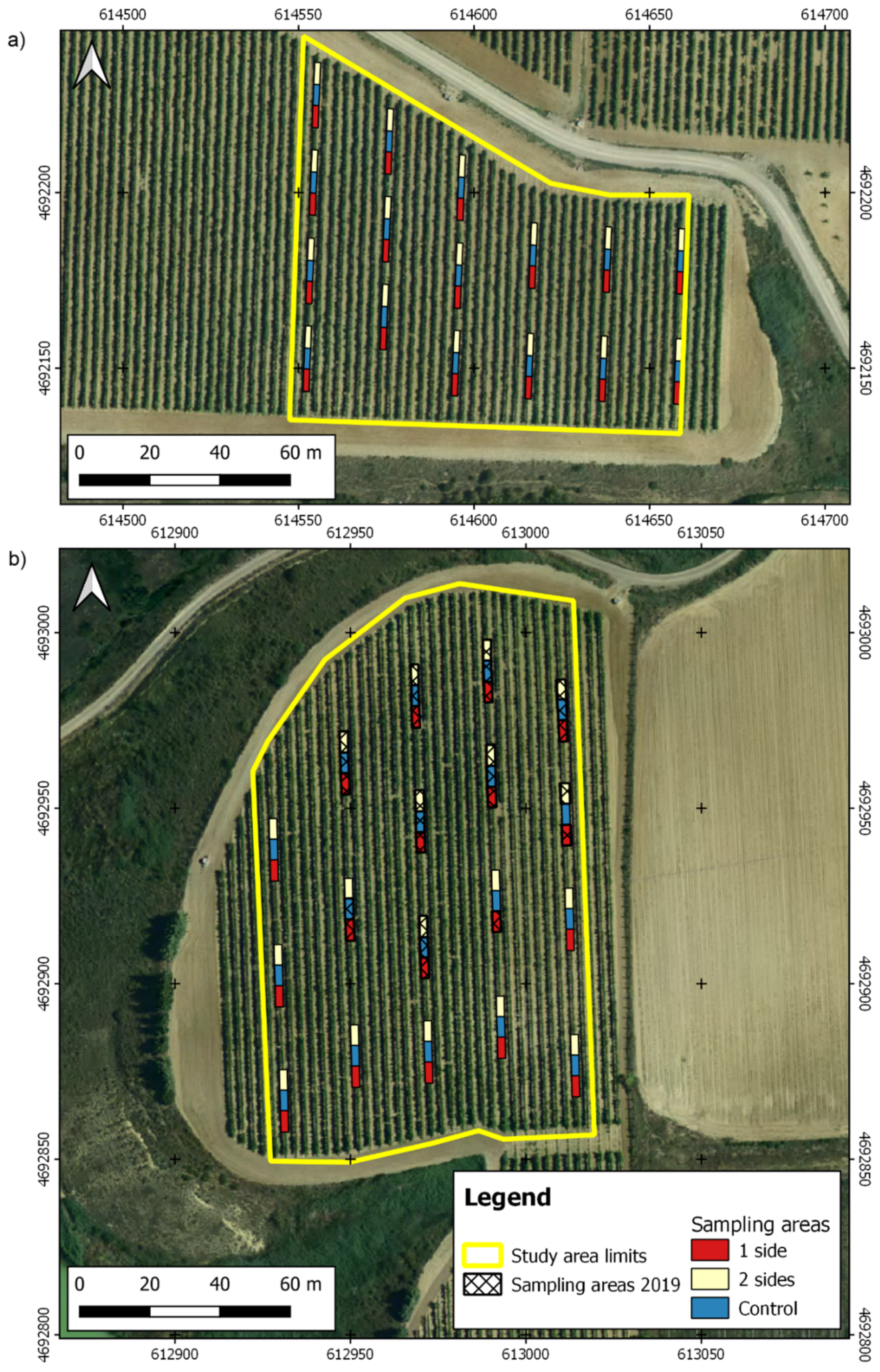
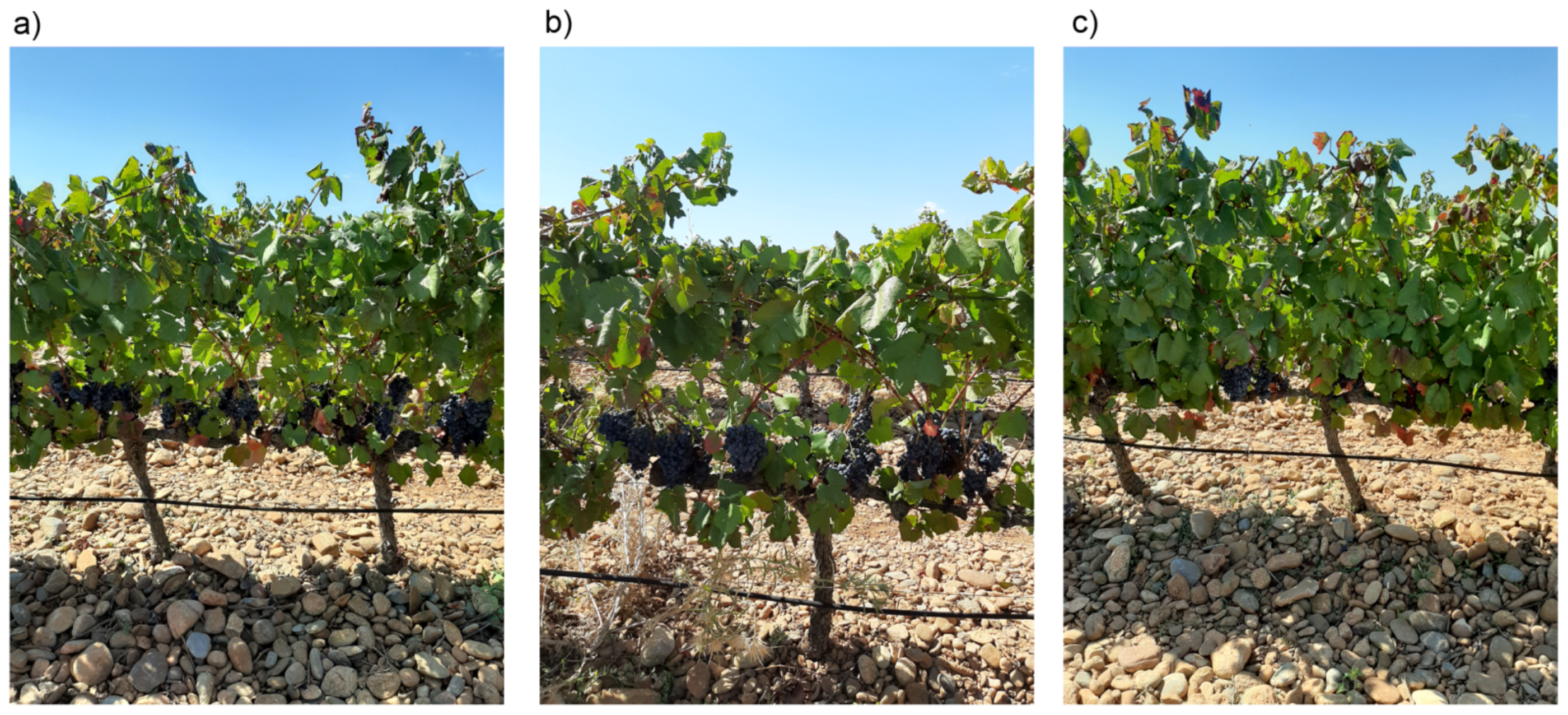
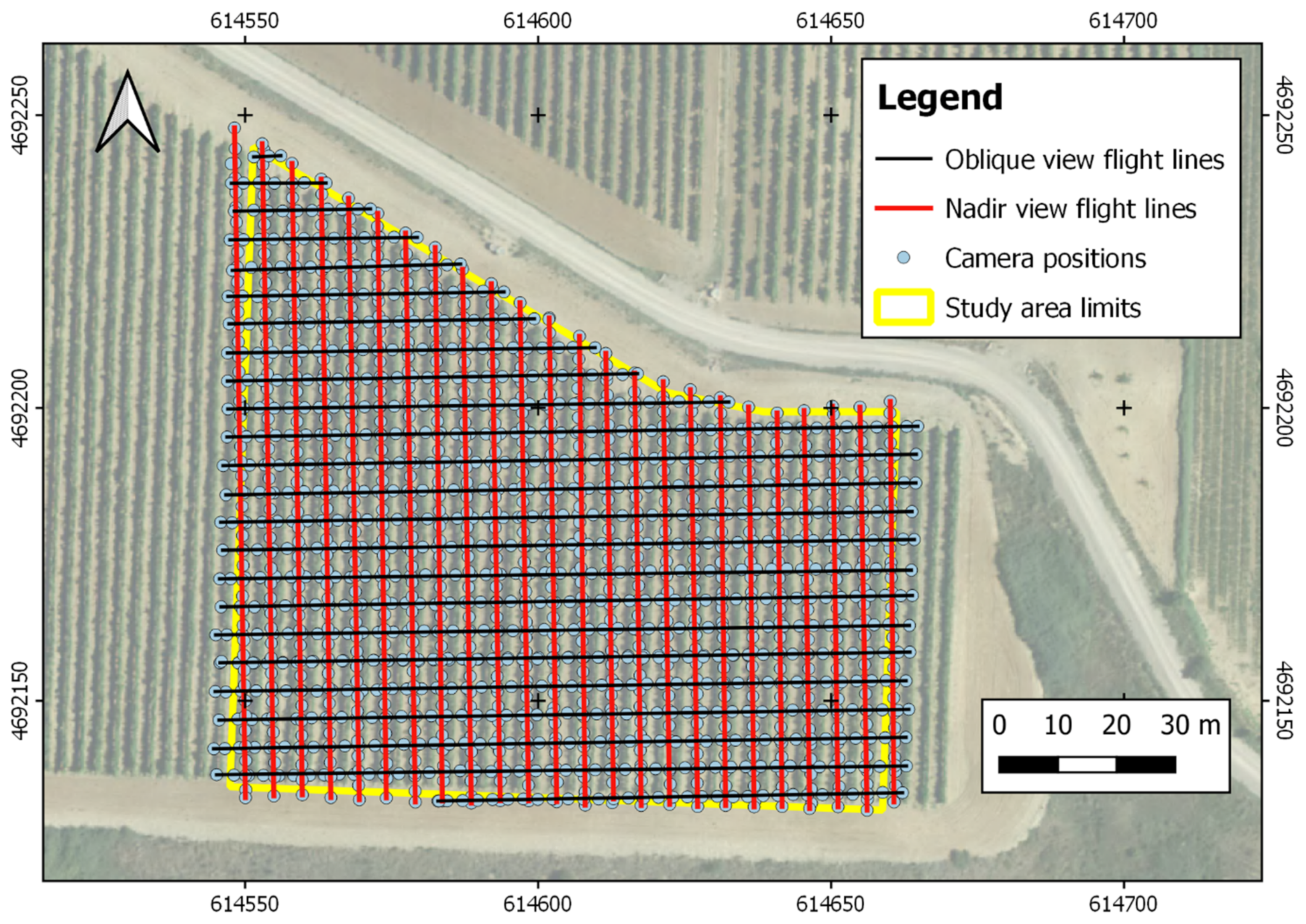

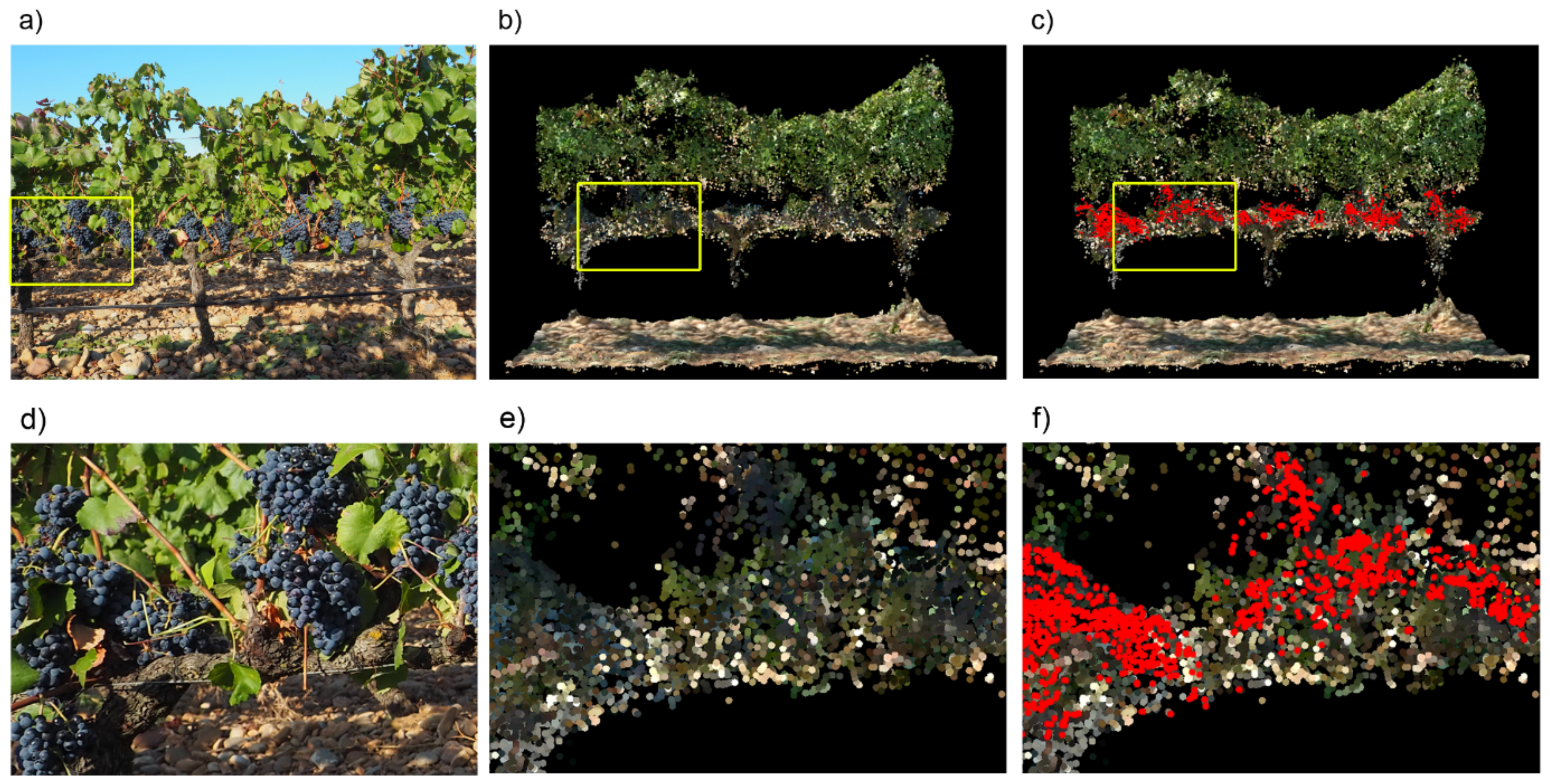
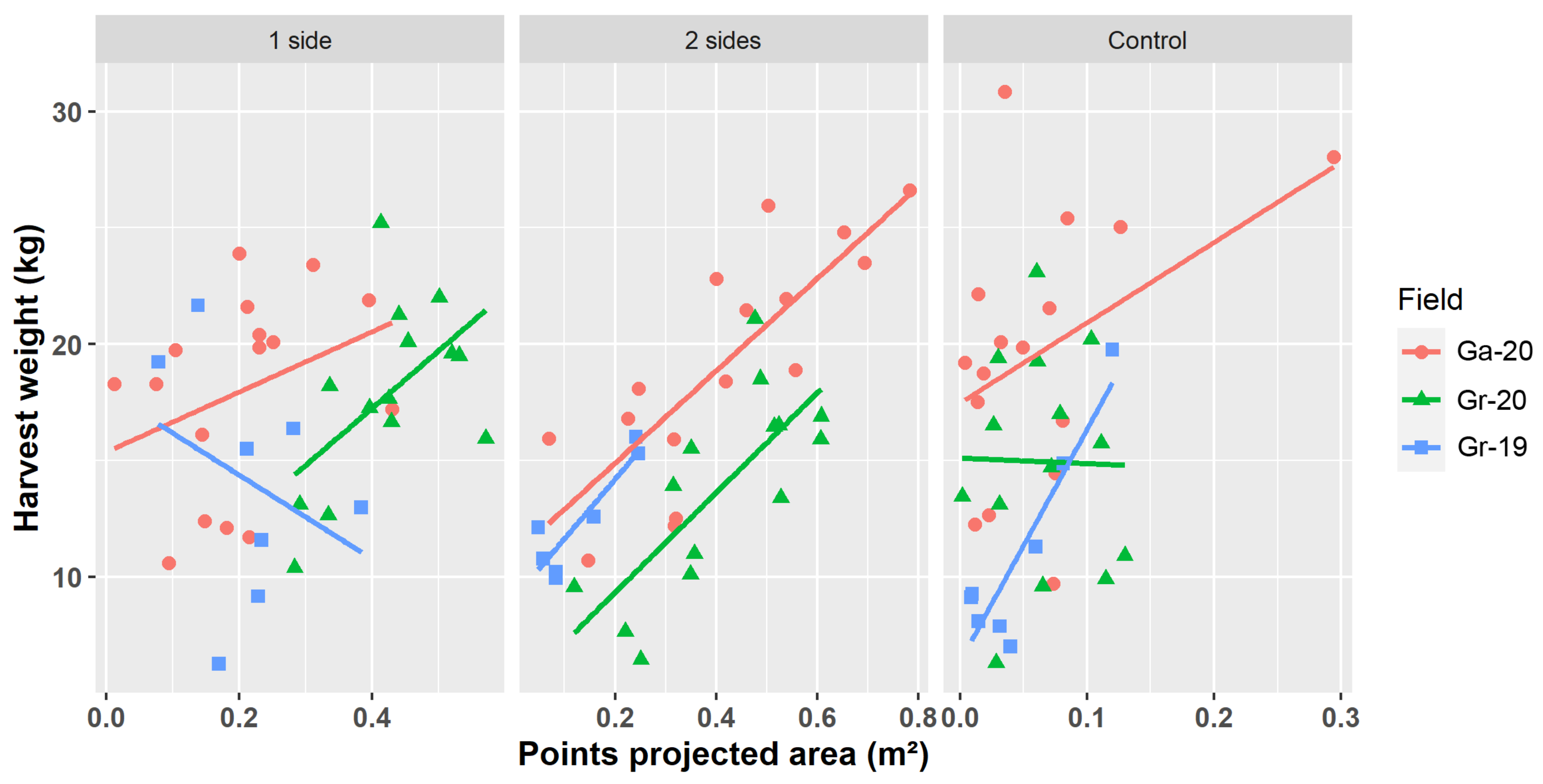
| Treatment | Field | Sampling Areas | R2 for Detected Points | R2 for Projected Area of Detected Points |
|---|---|---|---|---|
| One side leaf removal | Gr-19 | 8 | 0.09 ns | 0.11 ns |
| Gr-20 | 14 | 0.02 ns | 0.31 * | |
| Ga-20 | 16 | 0.05 ns | 0.11 ns | |
| Gr-19 + Ga-20 | 24 | 0.05 ns | 0.01 ns | |
| All | 38 | 0.00 ns | 0.06 ns | |
| Two sides leaf removal | Gr-19 | 7 | 0.57 ns | 0.81 *** |
| Gr-20 | 14 | 0.55 ** | 0.56 ** | |
| Ga-20 | 16 | 0.48 ** | 0.63 *** | |
| Gr-19 + Ga-20 | 23 | 0.59 *** | 0.77 *** | |
| All | 37 | 0.35 *** | 0.52 *** | |
| Control | Gr-19 | 8 | 0.66 * | 0.82 ** |
| Gr-20 | 14 | 0.01 ns | 0.00 ns | |
| Ga-20 | 16 | 0.18 ns | 0.17 ns | |
| Gr-19 + Ga-20 | 24 | 0.11 ns | 0.22 * | |
| All | 38 | 0.05 ns | 0.13 * |
Publisher’s Note: MDPI stays neutral with regard to jurisdictional claims in published maps and institutional affiliations. |
© 2021 by the authors. Licensee MDPI, Basel, Switzerland. This article is an open access article distributed under the terms and conditions of the Creative Commons Attribution (CC BY) license (https://creativecommons.org/licenses/by/4.0/).
Share and Cite
Torres-Sánchez, J.; Mesas-Carrascosa, F.J.; Santesteban, L.-G.; Jiménez-Brenes, F.M.; Oneka, O.; Villa-Llop, A.; Loidi, M.; López-Granados, F. Grape Cluster Detection Using UAV Photogrammetric Point Clouds as a Low-Cost Tool for Yield Forecasting in Vineyards. Sensors 2021, 21, 3083. https://doi.org/10.3390/s21093083
Torres-Sánchez J, Mesas-Carrascosa FJ, Santesteban L-G, Jiménez-Brenes FM, Oneka O, Villa-Llop A, Loidi M, López-Granados F. Grape Cluster Detection Using UAV Photogrammetric Point Clouds as a Low-Cost Tool for Yield Forecasting in Vineyards. Sensors. 2021; 21(9):3083. https://doi.org/10.3390/s21093083
Chicago/Turabian StyleTorres-Sánchez, Jorge, Francisco Javier Mesas-Carrascosa, Luis-Gonzaga Santesteban, Francisco Manuel Jiménez-Brenes, Oihane Oneka, Ana Villa-Llop, Maite Loidi, and Francisca López-Granados. 2021. "Grape Cluster Detection Using UAV Photogrammetric Point Clouds as a Low-Cost Tool for Yield Forecasting in Vineyards" Sensors 21, no. 9: 3083. https://doi.org/10.3390/s21093083
APA StyleTorres-Sánchez, J., Mesas-Carrascosa, F. J., Santesteban, L.-G., Jiménez-Brenes, F. M., Oneka, O., Villa-Llop, A., Loidi, M., & López-Granados, F. (2021). Grape Cluster Detection Using UAV Photogrammetric Point Clouds as a Low-Cost Tool for Yield Forecasting in Vineyards. Sensors, 21(9), 3083. https://doi.org/10.3390/s21093083







